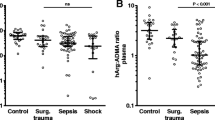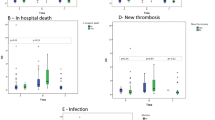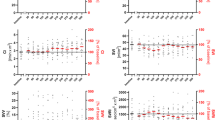Abstract
The aim of this study was to monitor nitric oxide blood levels at various times intraoperatively and following liver transplantation in humans. Nitric oxide production was assessed directly as circulating nitrosyl-hemoglobin adducts by electron paramagnetic resonance spectroscopy in 22 patients undergoing orthotopic liver transplantation. Two significant peaks in nitrosyl-hemoglobin levels were detected at 5 and 60 min after reperfusion (5.02 ± 3.33 arbitrary units and 5.75 ± 4.19, respectively, vs 3.33 ± 2.28 under basal state; P < 0.05 for both comparisons). Postoperative nitrosyl-hemoglobin levels remained elevated, up to 5.42 ± 0.89 arbitrary units (P < 0.05 vs basal values). Neither soluble intercellular adhesion molecule- 1 or soluble endothelial-leukocyte adhesion molecule concentrations were altered intraoperatively. Only the former was significantly raised after transplantation. Neutrophil elastase levels showed an early increase and remained high throughout surgery, returning to basal values after transplantation. No correlations were found among studied parameters. These data suggest that nitric oxide may play a role in ischemia–reperfusion phases in human liver transplantation. Mechanisms other than leukocyte-endothelial adhesion and neutrophil activation seem to affect nitric oxide production under these conditions.
Similar content being viewed by others
REFERENCES
Lefer AM, Lefer DJ: The role of nitric oxide and cell adhesion molecules on the microcirculation in ischaemia-reperfusion. Cardiovasc Res 32:743–751, 1996
Kuo PC, Alfrey EJ, Abe K, Huie P, Sibley RK, Dafoe DC: Cellular localization and effect of nitric oxide synthesis in a rat model of orthotopic liver transplantation. Transplantation 61:305–312, 1996
Mayer B, Hemmens B: Biosynthesis and action of nitric oxide in mammalian cells. Trends Biochem Sci 22:477–481, 1997
Äggäd E: Nitric oxide: mediator, murderer, and medicine. Lancet 343:1199–1206, 1994
Peralta C, Hotter G, Closa D, Gelpi E, Bulbena O, Rosello-Catafau J: Protective effect of preconditioning on the injury associated to hepatic ischemia-reperfusion in the rat: Role of nitric oxide and adenosine. Hepatology 25:934–937, 1997
Pannen BHJ, Al-Adili F, Bauer M, Clemens MG, Geiger KK: Role of endothelins and nitric oxide in hepatic reperfusion injury in the rat. Hepatology 27:755–764, 1998
Koeppel TA, Thies JC, Schemmer P, Trauner M, Gebhard MM, Otto G, Post S: Inhibition of nitric oxide synthesis in ischemia/reperfusion of the rat liver is followed by impairment of hepatic microvascular blood flow. J Hepatol 27:163–169, 1997
Clavien PA: Sinusoidal endothelial cell injury during hepatic preservation and reperfusion. Hepatology 28:281–285, 1998
Forde RC, Desmond DJ: Reactive oxygen species and platelet activation in reperfusion injury. Circulation 95:787–789, 1997
Clavien PA, Camargo CA, Gorczynski R, Washington MK, Levy GA, Langer B, Greig PD: Acute reactant cytokines and neutrophil adhesion after warm ischemia in cirrhotic and noncirrhotic human livers. Hepatology 23:1456–1463, 1996
Lichtman SN, Lemasters JJ: Role of cytokines and cytokine-producing cells in reperfusion injury to the liver. Semin Liver Dis 19:171–187, 1999
Moncada S, Higgs A: The L-arginine/nitric oxide pathway. N Engl J Med 329:2002–2012, 1993
Rosser BG, Gores GJ: Liver necrosis: Cellular mechanisms and clinical implications. Gastroenterology 108:252–275, 1995
Jaeschke H, Farhood A, Smith CW: Neutrophils contribute to ischemia/reperfusion injury in rat liver in vivo. FASEB J 4:3355–3359, 1990
Hickey M, Kubes P: Role of nitric oxide in regulation of leukocyte-endothelial cells interactions. Exp Physiol 82:339–348, 1997
Ioannidis I, Hellinger A, Dehmlow C, Rauen U, Erhard J, Eigler FW, De Groot H: Evidence for increased nitric oxide production after liver transplantation in humans. Transplantation 59:1293–1297, 1995
Devlin J, Palmer RM, Gonde CE, O'Grady J, Heaton N, Tan KC, Martin JF, Moncada S, Williams R: Nitric oxide generation—a predictive parameter of acute allograft rejection. Transplantation 58:592–595, 1994
Battista S, Bar F, Mengozzi G, Zanon E, Grosso M, Molino G. Hyperdynamic circulation in patients with cirrhosis: Direct measurement of nitric oxide levels in hepatic and portal veins. J Hepatol 26:75–80, 1997
Kosaka H, Sawai Y, Sakaguchi H, Kumura E, Harada N, Watanabe M, Shiga T: ESR spectral transition by arteriovenous cycle in nitric oxide hemoglobin of cytokine-treated rats. Am J Physiol 266:C1400–C1405, 1994
Esteban F, Gomez-Jimenez J, Martin MC, Ruiz JC, Nuvials X, Garcia-Allut JL, Sauri R, Murio JE, Mourelle M, Segura RM: Nitric oxide and hepatic ischemic injury in human orthotopic liver transplantation. Transplant Proc 27:2283–2285, 1995
Kiechle FL, Malinski T: Nitric oxide— biochemistry, pathophysiology and detection. Am J Clin Pathol 100:567–575, 1993
Henry Y, Lepoivre M, Drapier JC, Ducrocq C, Boucher JL, Guissani A: EPR characterization of molecular targets for NO in mammalian cells and organelles. FASEB J 7:1124–1134, 1993
Serizawa A, Nakamura S, Suzuki S, Baba S, Nakano M: Involvement of platelet-activating factor in cytokine production and neutrophil activation after hepatic ischemia-reperfusion. Hepatology 23:1656–1663, 1996
Bzeizi KI, Jalan R, MacGregor I, Drummond O, Lee A, Hayes PC: Neutrophil elastase: A determinant of endothelial damage and reperfusion injury after liver transplantation? Transplantation 62:916–920, 1996
Ma T, Ischiropoulos H, Brass CA: Endotoxin-stimulated nitric oxide production increases injury and reduces rat liver chemiluminescence during reperfusion. Gastroenterology 108:463–469, 1995
Melillo G, Musso T, Sica A, Taylor LS, Cox GW, Varesio L: A hypoxia-responsive element mediates a novel pathway of activation of the inducible nitric oxide synthase promoter. J Exp Med 182:1683–1693, 1995
Pesonen EJ, Linder N, Raivio KO, Sarnesto A, Lapatto R, Hockerstedt K, Makisalo H, Andersson S: Circulating xanthine oxidase and neutrophil activation during human liver transplantation. Gastroenterology 114:1009–1015, 1998
Carreras MC, Pargament GA, Catz SD, Poderosso JJ, Boveris A: Kinetics of nitric oxide and hydrogen peroxide production and formation of peroxynitrite during the respiratory burst of human neutrophils. FEBS Lett 341:65–68, 1994
Längle F, Roth E, Steininger R, Winkler S, Mühlbacher F: Arginase release following liver reperfusion. Transplantation 59:1542–1549, 1995
Roth E, Steininger R, Winkler S, Längle F, Grunberger T, Függer R, Mühlbacher F: L-Arginine deficiency after liver transplantation as an effect of arginase efflux from the graft—Influence of nitric oxide metabolism. Transplantation 57:665–669, 1994
Eiserich JP, Hristova M, Cross CE, Jones AD, Freeman BA, Halliwell B, van der Vliet A: Formation of nitric oxide-derived inflammatory oxidants by myeloperoxidase in neutrophils. Nature 391:393–397, 1998
Toledo-Pereyra LH, Suzuki S: Neutrophils, cytokines and adhesion molecules in hepatic ischemia and reperfusion injury. J Am Coll Surg 179:758–762, 1994
Jaeschke H: Cellular adhesion molecules: regulation and functional significance in pathogenesis of liver diseases. Am J Physiol 273:G602–G611, 1997
Yamaguchi Y, Matsumura F, Takeya M, Ichiguchi O, Kuratsu JI, Horiuchi T, Akizuki E, Matsuda T, Okabe K, Ohshiro H, Liang J, Mori K, Yamada S, Takahashi K, Ogawa M: Monocyte chemoattractant protein-1 enhances expression of intercellular adhesion molecule-1 following ischemia-reperfusion of the liver in rats. Hepatology 27:727–734, 1998
Sakamoto S, Okanoue T, Itoh Y, Sakamoto K, Nishioji K, Nakagawa Y, Yoshida N, Yoshikawa T, Kashima K: Intercellular adhesion molecule-1 and CD18 are involved in neutrophil adhesion and its cytotoxicity to cultured sinusoidal endothelial cells in rats. Hepatology 26:658–663, 1997
Ninova D, Krom RA, Wiesner RH: Hepatic allograft rejection is associated with increased levels of soluble intercellular adhesion molecule-1. Liver Transpl Surg 1(5):290–295, 1995
Biasi F, Bosco M, Chiappino I, Chiarpotto E, Lanfranco G, Ottobrelli A, Massano G, Donadio PP, Vaj M, Andorno E, Poli G: Oxidative damage in human liver transplantation. Free Rad Biol Med 19:311–317, 1995
Shiraishi M, Kusano T, Aihara T: Protection against hepatic ischemia/reperfusion injury by exogenous L-arginine. Transplant Proc 28:1887–1888, 1996
Jones SM, Thurman RG: L-arginine minimizes reperfusion injury in a low-flow, reflow model of liver perfusion. Hepatology 24:163–168, 1996
Author information
Authors and Affiliations
Rights and permissions
About this article
Cite this article
Battista, S., Mengozzi, G., Bar, F. et al. Nitric Oxide Level Profile in Human Liver Transplantation. Dig Dis Sci 47, 528–534 (2002). https://doi.org/10.1023/A:1017903716514
Issue Date:
DOI: https://doi.org/10.1023/A:1017903716514




